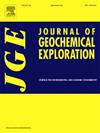黄铁矿原地热电性与地球化学:对大瑶山龙华镍钴脉状矿床的找矿意义
IF 3.3
2区 地球科学
Q1 GEOCHEMISTRY & GEOPHYSICS
引用次数: 0
摘要
黄铁矿热电法已广泛应用于深部/隐伏石英脉相关金矿体预测。然而,该方法能否作为镍钴矿勘查的载体,仍有待探讨。研究了龙华镍钴矿床3号矿体纵向剖面(海拔531 m、492 m和446 m)上黄铁矿的主元素组成、微量元素组成和热电特征,评价了其找矿潜力。矿床中镍钴矿化主要为砷化物(如镍矿)、硫化物(如辉锑矿和钴矿)和硫化物(如镍锑矿和硼锑矿),主要赋存于石英脉中。野外观察表明,不同海拔的黄铁矿与镍钴矿物密切相关。不同海拔高度黄铁矿中Co、Ni和As的时间分辨LA-ICP-MS深度剖面呈现出平缓的曲线,表明这些元素主要以同构形式结合到黄铁矿晶格中。尽管Co/Ni比值相对较低(大部分为<;1),但石英脉控制的黄铁矿赋存指向热液成因。微量元素沿垂直剖面呈循环变化,从531 m到492 m再到446 m a.s.l, (Co + Ni)含量先降低后增加,而As含量呈相反趋势。相应地,黄铁矿热电性在531 m时由n型电导率转变为492 m时的p型电导率,在446 m时又恢复为n型电导率。这种变化归因于(Co + Ni)含量与n型电导率、As含量与p型电导率之间的直接联系。观察到砷化矿与p型黄铁矿、硫化矿与n型黄铁矿的结合,确立了这些电导率类型作为不同成矿特征的标志。此外,446 m a.s.l.以下的硫逸度增加,加上430 m a.s.l.(沿3号矿体推断延伸的钻孔)存在n型黄铁矿,表明在目前研究的446 m a.s.l.下可能存在更深层次的富硫化物成矿。本研究强调了利用黄铁矿热电性和地球化学特征指导镍钴矿找矿的可行性。本文章由计算机程序翻译,如有差异,请以英文原文为准。
In situ pyrite thermoelectricity and geochemistry: Implications for exploration in the Longhua Ni-Co vein deposit, Dayaoshan area, South China
Pyrite thermoelectricity has been widely utilized in predicting deep/concealed quartz-vein-related gold orebodies. However, whether this methodology can be utilized as vector for Ni-Co mineral exploration remains to be explored. This study investigates the major element composition, trace element composition, and thermoelectric characteristics of pyrite across a vertical profile (531 m, 492 m, and 446 m above sea level, a.s.l.) along the No. 3 orebody of the Longhua Ni-Co deposit to evaluate their potential for Ni-Co exploration. In this deposit, Ni-Co mineralization is dominated by arsenides (e.g., niccolite), sulfarsenides (e.g., gersdorffite and cobaltite), and sulfides (e.g., pentlandite and bravoite), which are primarily hosted in quartz veins. Field observations indicate that pyrite from different elevations is closely associated with Ni-Co ore minerals. Time-resolved LA-ICP-MS depth profiles of Co, Ni, and As in pyrite from different elevations exhibit gentle curves, suggesting that these elements primarily incorporate into the pyrite lattice in an isomorphic form. Despite a relatively low Co/Ni ratio (mostly <1), the quartz-vein-controlled occurrence of pyrite points to a hydrothermal origin. The trace elements exhibit a cyclic variation along the vertical profile: from 531 m to 492 m and then to 446 m a.s.l., the (Co + Ni) content initially decreases then increases, while As content shows an inverse trend. Correspondingly, pyrite thermoelectricity changes from N-type conductivity at 531 m a.s.l. to P-type at 492 m a.s.l., and reverting to N-type at 446 m a.s.l. This variation is attributed to a direct link between (Co + Ni) content and N-type conductivity, and between As content and P-type conductivity. The observed association of arsenide ores with P-type pyrite and sulfide ores with N-type pyrite establishes these conductivity types as indicators for distinct mineralization characteristics. Furthermore, the increase in sulfur fugacity below 446 m a.s.l., combined with the presence of N-type pyrite at 430 m a.s.l. (from drill-hole along the inferred extension of the No. 3 orebody), indicates the potential for deeper sulfide-rich mineralization below currently investigated 446 m a.s.l. drift. This study highlights the feasibility of using the pyrite thermoelectricity and geochemistry to guide the Ni-Co mineral exploration.
求助全文
通过发布文献求助,成功后即可免费获取论文全文。
去求助
来源期刊

Journal of Geochemical Exploration
地学-地球化学与地球物理
CiteScore
7.40
自引率
7.70%
发文量
148
审稿时长
8.1 months
期刊介绍:
Journal of Geochemical Exploration is mostly dedicated to publication of original studies in exploration and environmental geochemistry and related topics.
Contributions considered of prevalent interest for the journal include researches based on the application of innovative methods to:
define the genesis and the evolution of mineral deposits including transfer of elements in large-scale mineralized areas.
analyze complex systems at the boundaries between bio-geochemistry, metal transport and mineral accumulation.
evaluate effects of historical mining activities on the surface environment.
trace pollutant sources and define their fate and transport models in the near-surface and surface environments involving solid, fluid and aerial matrices.
assess and quantify natural and technogenic radioactivity in the environment.
determine geochemical anomalies and set baseline reference values using compositional data analysis, multivariate statistics and geo-spatial analysis.
assess the impacts of anthropogenic contamination on ecosystems and human health at local and regional scale to prioritize and classify risks through deterministic and stochastic approaches.
Papers dedicated to the presentation of newly developed methods in analytical geochemistry to be applied in the field or in laboratory are also within the topics of interest for the journal.
 求助内容:
求助内容: 应助结果提醒方式:
应助结果提醒方式:


